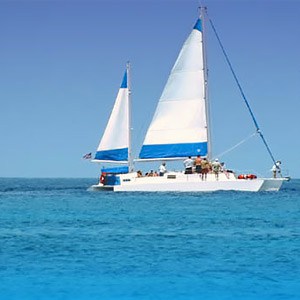Please Register / Login to take part in discussions about the Virgin Islands.
Hello. I searched this forum and Google for info on poison ivy/oak/sumac or similar plants in the VI's, and found somewhat conflicting info. Some people said they didn't see any, others said they got a "poison ivy-like" rash. Questions: are one or more of these found in the islands? Is there a similar plant to avoid? If so, what does it look like or what is the name so I can search for a picture? Issue is deciding how much protective clothing to wear and/or how closely to watch for this on hikes, particularly on STJ. Several family members are known to be highly sensitive to poison ivy.
Thanks!
And if anyone has noticed...my questions here have tended to be about personal safety (rashes, falling off cliffs, drowning, etc.). I am also gathering info on fun stuff! Not just a nervous type all of the time. 🙂 Have appreciated all info!
There is a plant called "Christmas Bush" If you go to photo 42 at the following link you (hopefully) see a photo.
http://donwiss.com/pictures/St-John-2006/h0042.htm
Christmas Bush (Comocladia dodonaeae). It produces a nasty, itchy rash like poison ivy.
Pia
Oh I forgot - I have never seen any on the "main" part of any trails. The only place I have seen it in a location where it could be easily touched is on Haulover Bay to the far right of the bay (as you are looking at the water) back a few feet from where the scrub brush starts.
Pia
Thanks Pia. A shame it's nasty...it's lovely. Thanks so much for the picture link so we can avoid!
C_Cmom
C Cmom,
Poisen Ivy type rash......MANGO'S!!!!
Mango's can cause a rash that is simular to poisen Ivy and I have heard that they are a related family!
Those who are sensitive, should not hang out below a Mango tree or touch the fruit! Most can eat Mango, but cannot touch the skin!
Hope this helps!
Thanks Sherri! I do remember having heard that before, now that you mention it. Fortunately I'm not crazy about mangoes, but might get in a "tropical" mood if around some. Thanks for the reminder!
I also understand there is a tree (?Machineel?) that is all about toxins, but that there aren't many of these around, and perhaps have labels/signs? Does that sound right?
C_Cmom
CC Mom,
My husband reacts strongly to poison ivy since he pulled some up when landscaping at our new home a few years back. He's had several very bad attacks, once even from inhaling smoke from a brush fire that someone started out in the country. Anyway, this has nothing to do with the island, but I wanted to warn you about fig trees. We have (or had) several small fig trees around our land and my husband scratched his arm on the branches while mowing and developed a severe poison ivy type reaction. We found out that they are also related! So now he avoids poison ivy (of course), mango trees, and fig trees. Just thought I'd let you know in case you didn't and lived around fig trees. My husband really wishes he had known!
The manchineel trees on STJ which are close to tourist areas are generally marked with a cautionary sign. One would be hard pressed to even try to eat the manchineel's "fruit" even when in season but some people who are allergic and happen to take shelter in a sporadic rain shower underneath this tree may well have a problem. The tree's sap is quite toxic particularly to those with allergic reactions to such as poison ivy.
I'm forgetting my past research but I believe that the manchineel, along with many other plant species, were brought here on trading vessels in primarily the late 17th to early 19th centuries, Not in tree or adult form, obviously, but in seeds tagged on to the usual shipments from other tropical climes.
Lore has it that in days of yore, slaves ground up the manchineel fruit and fed it to their slavemasters in food and drinks, sometimes leading to the demise of their masters. My basic research showed no documentation of such but it's quite possible that some slaves just might have brewed up some manchineel and afforded some of those few unkind masters a good case of the runs!
I would venture to say that you'll have no problems hiking on established trails on STJ as they're pretty much cleared by the National Park Service by whom they're maintained. If you go out by Ramshead, best to wear solid shoes as those cactus barbs can run through a simple sneaker or a rubber t'ong with great ease and end up embedded in your foot.
Mangoes? I will not go there right now as that's another story for another time! Cheers and good night!
I am "allergic" to mangos. If they are in bite-sized pieces, I can eat them with a fork. And I can peel them without problem. But if I peel and then eat like an apple, I have a reaction around my mouth very much like poison ivy..
Glad I was able to contribute! The only reason I knew about this is that my fiance's son reacts horribly to Mangoes, he can eat them, but if he goes near a tree that is producing, he gets covered with a rash! Poor kid!
Mangoes are out now, so be careful! 🙂
Cool. Helpful info and an interesting historical story, too! Thanks all!
C_Cmom



